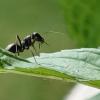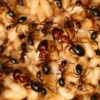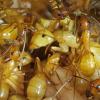So I caught this queen on May 24, 2019. She had what appeared to be underdeveloped hind wings (and maybe they are rotting or something idk) and found her in the middle of a T. immigrans flight (none of which had this). I'm pretty sure this is a Pheidole sp. Now, this wouldn't usually raise too many concerns but when I came back the next day after placing her in a tube setup, there was a bunch of white fluid (dried?) stuck on the glass and in a pattern as if it was dragged or rubbed all over. So... I'm not certain what to think of that.
I've been away for a week so I don't know how this has progressed but I'm uncertain of what this is. Is this a disease and I should work to contain the contamination? A sign of a parasite?
Here is a picture.



















